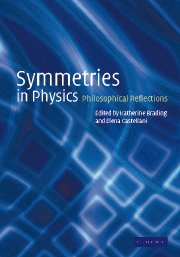Book contents
- Frontmatter
- Contents
- List of contributors
- Preface
- Copyright acknowledgements
- 1 Introduction
- Part I Continuous symmetries
- Part II Discrete symmetries
- Part III Symmetry breaking
- 17 Classic texts: extracts from Curie and Weyl
- 18 Cross fertilization in theoretical physics: the case of condensed matter and particle physics
- 19 On the meaning of symmetry breaking
- 20 Rough guide to spontaneous symmetry breaking
- 21 Spontaneous symmetry breaking: theoretical arguments and philosophical problems
- Part IV General interpretative issues
- Index
18 - Cross fertilization in theoretical physics: the case of condensed matter and particle physics
Published online by Cambridge University Press: 08 October 2009
- Frontmatter
- Contents
- List of contributors
- Preface
- Copyright acknowledgements
- 1 Introduction
- Part I Continuous symmetries
- Part II Discrete symmetries
- Part III Symmetry breaking
- 17 Classic texts: extracts from Curie and Weyl
- 18 Cross fertilization in theoretical physics: the case of condensed matter and particle physics
- 19 On the meaning of symmetry breaking
- 20 Rough guide to spontaneous symmetry breaking
- 21 Spontaneous symmetry breaking: theoretical arguments and philosophical problems
- Part IV General interpretative issues
- Index
Summary
The following text is part of a talk entitled ‘Cross Fertilization in Theoretical Physics: the Case of Condensed Matter and Particle Physics’ given at the Young Researchers Symposium held on the occasion of the XIII International Congress on Mathematical Physics, London, 17–22 July 2000. One of the purposes of the symposium was the communication of personal experiences and points of view on the part of older researchers and this is reflected in the style of exposition.
The full text appears in Highlights in Mathematical Physics, edited by A. Fokas, J. Halliwell, T. Kibble, and B. Zegarlinski, and published in 2002 by the American Mathematical Society.
Breaking gauge and chiral invariance
Spontaneous breakdown of symmetry (SBS) is a concept that is applicable only to systems with infinitely many degrees of freedom. Although it pervaded the physics of condensed matter for a very long time – magnetism is a prominent example – its formalization and the recognition of its importance has been an achievement of the second half of the twentieth century. Strangely enough, the name was adopted only after its introduction in particle physics: it is due to Baker and Glashow (1962). I think that concepts acquire a proper name only when they attain their full maturity: this emphasizes the relevance of this case that took place over forty years ago.
- Type
- Chapter
- Information
- Symmetries in PhysicsPhilosophical Reflections, pp. 315 - 320Publisher: Cambridge University PressPrint publication year: 2003
- 2
- Cited by

